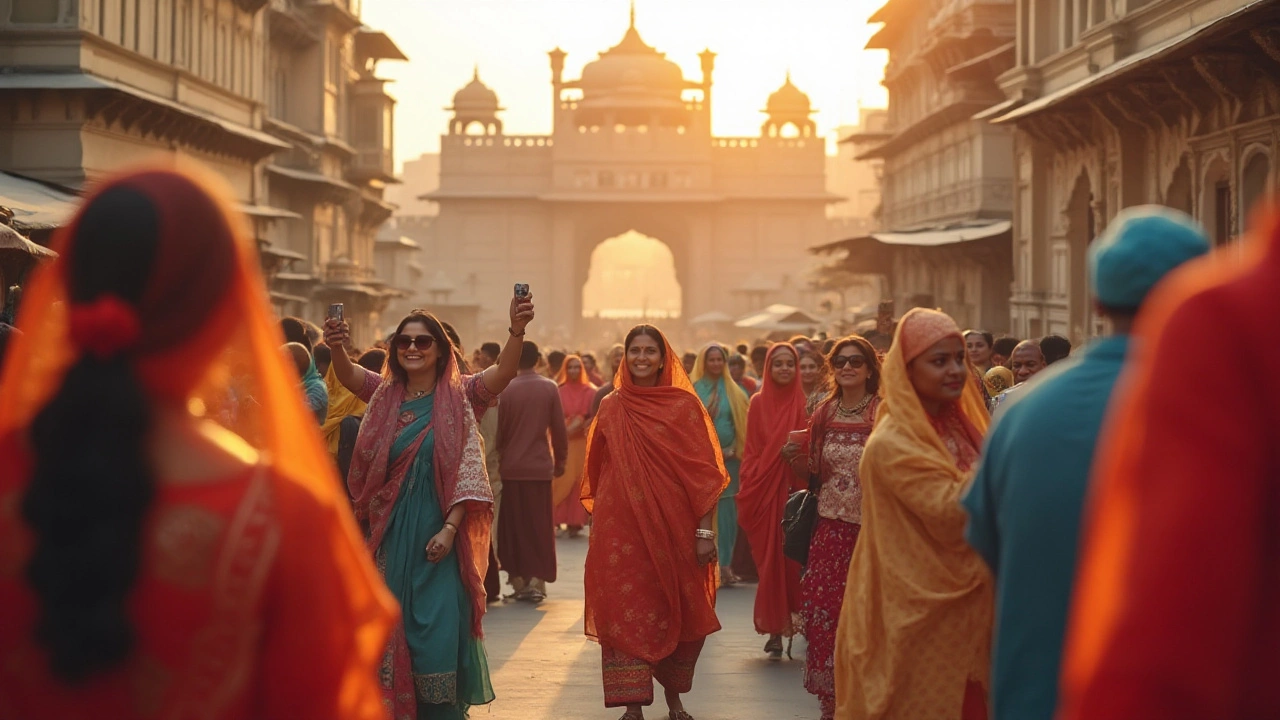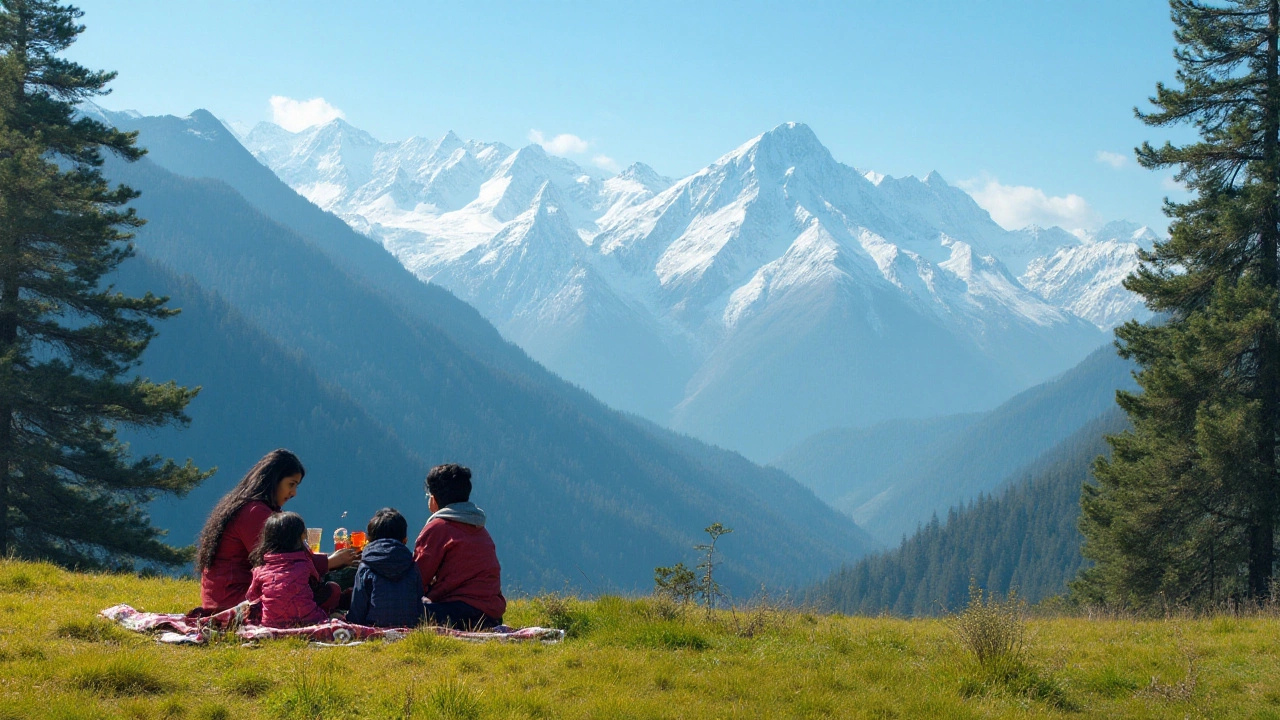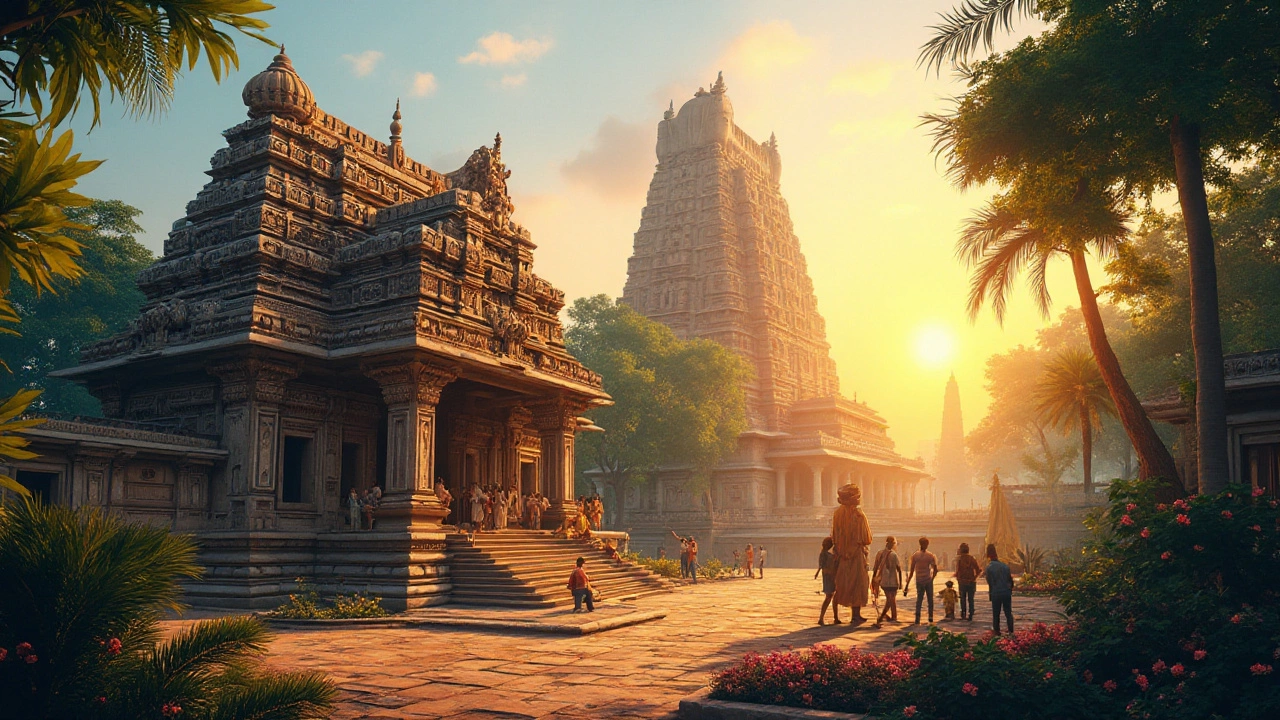Exploring Cultural and Geographic Differences Between North and South India

- Jan, 21 2025
- 0 Comments
- Aaron Blackwood
India, a country known for its diversity, presents a vibrant tapestry woven with contrasting cultures, landscapes, and traditions. The regions of North and South India exhibit their own unique flavors, making them captivating destinations for tourists from around the world. As you journey through these areas, you'll encounter a delightful mix of history, nature, and spirituality.
While North India lures you with its historic forts, palaces, and the majestic Himalayas, South India enchants with its lush greenery, pristine beaches, and centuries-old temples. Understanding the distinctive characteristics of these regions adds depth to the travel experience. This exploration not only conveys the fascinating differences but also the unifying essence of India as a whole.
- Geographic Landscape
- Cultural Traditions
- Languages and Dialects
- Cuisine Variations
- Tourism Hotspots
- Travel Tips and Recommendations
Geographic Landscape
When traversing the vast expanse of India, the stark contrasts between the North India and South India geographic landscapes become immediately apparent. Dominated by the mighty Himalayas, the north is lavished with snow-capped peaks, sprawling valleys, and alpine rivers that carve ancient stories into the land. This part of India is home to the Indo-Gangetic plains, which stretch wide under a majestic sky. The fertile flatlands here are nourished by the sacred rivers like the Ganges and Yamuna, making them the cradle of ancient civilizations and vibrant modern cities such as Delhi and Varanasi.
In stark contrast, the southern region is blessed with an entirely different kind of natural beauty – tropical in nature, lush, and unyieldingly green. The Western and Eastern Ghats frame the Deccan Plateau, creating a rich backdrop for the grand temples that dot the South Indian landscape. The backwaters of Kerala, often likened to a serene labyrinth, provide a tranquil setting for visitors seeking the serene side of nature. With pristine beaches, verdant plantations, and wildlife sanctuaries, South India stands as a lush testament to a tropical haven.
The southern coastlines along the Arabian Sea and the Bay of Bengal offer sandy beaches, mangrove forests, and a thriving marine ecosystem. The beaches of Goa and Kovalam have long been celebrated for their breathtaking beauty and relaxed atmosphere. This geographical divergence has also played a critical role in shaping the distinct cultures of both regions; while the north boasts a mountain-inspired resilience, the south exhibits a deep-rooted harmony with nature. As Indira Gandhi once described, "India is a land of diverse natural beauty but connected through its essence."
Cultural Traditions
India's cultural tapestry is perhaps best illustrated through the distinct traditions of North India and South India. These regions, though part of the same nation, display fascinating variations in celebrations, attire, dance, and music. The northern states, deeply influenced by historical empires like the Mughals, reflect a fusion of Central Asian, Persian, and indigenous traditions. Festivals such as Diwali and Holi are marked by vibrant displays of lights, colors, and elaborate social gatherings. Traditional clothing in the north includes the saree, salwar kameez, and in some cases, the majestic sherwani for men, often adorned with intricate embroidery.
In comparison, the cultural practices in South India remain closely knit with ancient Dravidian traditions, characterized by rich classical arts and orthodox religious customs. Here, festivals like Pongal and Onam are celebrated with equal aplomb, involving distinctive rituals and lavish feasts. An interesting observation is the prominence of the Carnatic music tradition, along with the classical dance form Bharatanatyam, which remains a significant part of South Indian heritage. The traditional clothing, predominantly silk sarees for women and veshti for men, often shines with bold and bright colors, reflecting the region's vibrant ethos.
"India is ancient yet always new. It is a land of so many cultures and customs that you will find everything you seek." — Pandit Ravi Shankar, renowned sitar virtuoso.
Architectural traditions offer yet another dimension of diversity between North and South India. The northern landscapes are dotted with awe-inspiring Mughal architecture, as evidenced in magnificent structures such as the Taj Mahal and the forts of Rajasthan. These edifices often feature grand domes, expansive courtyards, and elaborate carvings that narrate stories of past grandeur. On the other hand, South India is home to an array of spellbinding temple architecture. Temples such as the Meenakshi Temple in Tamil Nadu, with its towering gopurams and intricate sculptures, represent not only religious significance but also the area's focus on detail and artistic brilliance.
Religious practices too are indicative of regional disparities. While Hinduism predominates both terrains, Northern Indian spiritual customs often incorporate influences from Buddhism, Jainism, and Sikhism, reflecting a unique syncretic ethos. Visiting the Golden Temple in Amritsar or the monasteries in Ladakh immerses one into this diverse spiritual realm. South India, on the other hand, is a bastion of Hindu orthodoxy, where age-old traditions remain honored. The ancient texts, sung in melodious chants, and the rich temple rituals, all contribute to an environment that feels removed from the hustle of modernity.

Languages and Dialects
When traveling through the vast landscapes of India, the diversity in languages and dialects between the North and South India is both striking and profound. Linguistically, India is home to hundreds of languages, with each region boasting its own linguistic identity. In North India, Hindi serves as the predominant official language, spoken with various accents and influences. This region, enriched by history, has seen several other languages like Punjabi in Punjab, Urdu in parts of Delhi and Uttar Pradesh, and Kashmiri in Jammu and Kashmir, each adding its own melodic rhythm to the cultural soundscape.
In contrast, South India is a treasure trove of Dravidian languages. The major ones include Tamil, Telugu, Kannada, and Malayalam, each with centuries of literary tradition. Tamil Nadu, for instance, prides itself on Tamil, one of the oldest languages in the world. An intriguing fact about the linguistic differences here is that many Dravidian languages have retained their classical forms more faithfully than their Indo-Aryan counterparts. According to a survey by the Language Census of India, these languages are not just regional markers but also bearers of history that predates the Indo-Aryan colonization of the northern plains.
Moreover, the dialectal variations within each state add layers to the linguistic landscape. Take Telugu in Andhra Pradesh and Telangana, for instance. It changes in inflection and vocabulary from one corner of the state to another, creating a rich tapestry of sub-dialects. Similarly, Kannada spoken in the northern part of Karnataka subtly differs from the southern variation. This malleability of language in South India speaks to a deep cultural adaptability while retaining core linguistic traditions.
The linguistic variety across North and South India does more than distinguish the two regions; it captures the rich cultural and historical dynamics of these lands. As linguist David Crystal eloquently notes, "A language is not just words, it's a culture, a tradition, a unification of a community." The ability to converse in different tongues has long been a source of pride too, and many in India are multilingual, often speaking their regional language, Hindi, and English with fluidity. It's not uncommon to find a Tamilian fluent in English and Hindi, and likewise, someone from Haryana conversing comfortably in Punjabi and Hindi.
For tourists visiting these regions, gaining a basic understanding of local language nuances can enhance the travel experience profoundly. Greeting someone in their native language often results in a warm smile and can even lead to more meaningful interactions. So, whether you find yourself navigating the busy streets of Delhi or enjoying the tranquility of Kerala's backwaters, embracing the local language opens a window into the heart of India's cultural diversity. We recommend trying to learn a few basic phrases in the local language wherever you travel in India—it often makes the journey richer and more engaging.
Cuisine Variations
When traveling through India, one cannot help but notice the pronounced yet fascinating differences in the cuisine between the North and South. This diversity forms an essential part of the cultural experience in either region. Northern India's cuisine is influenced significantly by its climate and history, marked by a love for wheat, dairy, and rich, spicy curries. Think of butter-soaked naan and parathas, which pair perfectly with a fragrant chicken curry or the classic dal makhani. The Mughal influence is evident with dishes like biryani and kebabs gracing many tables, often cooked with dry fruits, ghee, and a flavor profile dominated by cinnamon, cloves, and cardamom. Family meals often center around a shared bread basket accompanied by a variety of pickles and sides.
Moving south, the cuisine takes a notably different turn, influenced by the tropical climate and abundant coastline. South India's dishes, often described as lighter and less rich, make ample use of rice, coconut, and various spices. The legendary dosa, a crispy yet soft pancake made from fermented rice batter, often filled with spiced potatoes, is a breakfast staple. When it comes to rice, biryanis here are distinct, with Hyderabadi biryani being a celebrated indulgence steeped in aromatic spices and layers of flavor. Coconut infuses itself into various curries and chutneys, providing a sweet counterpoint to the fiery spices.
Another standout is the extensive use of lentils and vegetables prepared as sambar or rasam, often served on a banana leaf, especially during traditional feasts. Food here is not just about flavor but also an experience. For instance, the tradition of serving meals on a banana leaf, considered hygienic and eco-friendly, also imparts a unique taste to the dishes. A symphony of textures and flavors, from the creamy coconut to the snap of mustard seeds in hot oil, makes dining in South India a unique affair.
If you can see humor in anything, you can survive it, mused Bill Bryson, a noted travel author, who aptly captured the essence of handling spicy Indian food with grace and humor.
While the spices and preparation techniques differ immensely, a shared love for spices and bold flavors unite North India and South India. India's culinary landscape is often a reflection of its intricate cultural tapestry, one that celebrates variety yet remains rooted in a shared history. As taste buds journey through these regions, travelers not only indulge in delicious food but also partake in centuries-old traditions. Whether you are savoring the rich gravies of the north or the tangy coconut-infusions of the south, each meal in India has a story, an identity, and a history waiting to be uncovered.

Tourism Hotspots
When exploring the dynamic landscape of North India, tourists will find themselves enchanted by its illustrious historical and cultural relics. The region boasts iconic sites like the Taj Mahal in Agra, a UNESCO World Heritage Site and one of the New Seven Wonders of the World. This ivory-white mausoleum captivates millions with its architectural brilliance and poignant story of eternal love. Further north, the Pink City of Jaipur offers a glimpse into the royal heritage of Rajasthan with its stunning forts and palaces, such as the Amber Fort and the City Palace, each echoing tales of ancient grandeur.
The northern expanse is also home to vibrant cities like Delhi, the capital, where modernity seamlessly blends with history. The Red Fort and India Gate stand as majestic symbols of the country's past and present. Journey northwards to experience the serene beauty of the Himalayas in Himachal Pradesh – from the spiritual vibes of Dharamshala, the home of the Dalai Lama, to the charming hill station of Shimla, known for its colonial-era architecture. A traveler once shared, "No matter how many times I visit the mountains of Himachal, I'm mesmerized each time anew by their untamed beauty."
In South India, a contrasting scenic voyage unfolds. This region, with its verdant landscapes and serene backwaters, offers a tranquil retreat. Kerala, termed "God’s Own Country," invites you to drift through the picturesque backwaters on a traditional houseboat. These languid waters, framed by swaying palm trees and lush greenery, offer a truly unique experience. Tamil Nadu, rich in Dravidian culture, is adorned with ancient temples that display exquisite craftsmanship, such as the sandstone marvel of Mahabalipuram or the towering gopurams of Madurai's Meenakshi Temple.
Coastal Gems
The golden beaches of Goa attract sun-seekers from across the globe, famous for their vibrant nightlife and historic Portuguese influence evident in its architecture. Meanwhile, Karnataka’s Coorg, dubbed the "Scotland of India," offers a lush, mist-covered hill station ripe for exploring and unwinding. According to a recent tourism report, approximately 40 million tourists visited this region in 2023, indicating a significant rise in its popularity.
Whether trekking through the mesmerizing trails of the Nilgiri Hills or enjoying the cultural festivity of a traditional temple festival, South India extends a wide spectrum of experiences. It’s wise to plan your itinerary in both North and South India according to the diverse climatic zones, as winter months from November to March are ideal for exploring the north, whereas the cooler monsoon months of June to September suit the southern region best.
Travel Tips and Recommendations
Embarking on a journey through the remarkable landscapes and cultures of North and South India demands more than just wanderlust; it calls for a well-crafted travel plan. Each region, with its unique charm and distinct experiences, requires thoughtful consideration to ensure an enriching visit. To make the most out of your adventure, whether you're unraveling the mysteries of Delhi's ancient capitals or soaking in the tranquility of Kerala's backwaters, consider these key travel tips to keep you on the right track.
One crucial aspect of planning a trip to North India is to account for climate variations. North India, with its rich diversity of terrain ranging from the mountainous regions of Himachal Pradesh to the desert state of Rajasthan, experiences extreme weather conditions. Winters can be harshly cold, especially in the Himalayan regions, so it's essential to pack appropriately with plenty of warm clothing and thermal wear. On the other hand, the summer months can become intensely hot, with temperatures soaring well above 40°C, requiring light, breathable clothing and appropriate sun protection. Meanwhile, the monsoon season brings heavy rainfall, particularly to places like Uttarakhand, which can affect travel plans due to landslides and roadblocks, making it important to monitor weather reports before travel.
As you make your way to the southern part of India, you’ll find a more tropical climate, with moderate temperatures year-round. Preparing for travel in South India means embracing a journey that offers lush settings, including the Western Ghats and idyllic coastlines. However, due to the region's humidity and occasional heavy rains from March to November, packing lightweight and moisture-wicking clothes is advisable. Additionally, cultural sensitivity is paramount, as South India’s traditions are deeply rooted in spirituality. Many temples enforce strict dress codes, so carrying extra ensembles like shawls or stoles for cover-up might be useful to respect the local customs when visiting sacred sites.
While traveling, language differences can pose challenges, albeit ones that can be navigated with a bit of forethought. North India sees languages such as Hindi and Punjabi dominating dialogue, but with a multitude of dialects sprinkled throughout, carrying a translation app or pocket phrasebook can be handy. In contrast, South India features diverse languages such as Tamil, Telugu, and Kannada. Although English speakers are prevalent due to an emphasis on education in the region, an effort to learn a few local greetings could win you some smiles and ease conversations as you traverse the vibrant local markets or scenic countryside.
Transportation in these vast regions also requires careful planning. North India's cities bustle with a blend of modernity and chaos, making local transport options like Delhi Metro, auto-rickshaws, or app-based cab services a convenient choice for urban exploration. Booking Indian Railways in advance is crucial for longer distances, allowing you to savor stunning views while getting to your next destination comfortably. In South India, buses and trains serve as reliable options to travel between cities, with regional airlines offering quick flights between states when time constraints arise. Renting a scooter or bicycle can add a dash of adventure to your journey, especially in more leisurely tourist hubs like Goa and Pondicherry.
Safety remains a top concern for any traveler, and both North and South India are generally welcoming to tourists. Yet, being vigilant is wise. Keep your belongings close in crowded areas, be cautious of pickpockets, and consider using money belts or neck pouches to keep valuables secure. Respect local laws and customs, including alcohol restrictions in certain areas and cultural norms governing behavior. If you have specific dietary concerns or health conditions, consult with local guides or hotel staff who are often more than willing to offer recommendations or accommodate needs, ensuring a hassle-free experience.
"India changes you forever, like nowhere else. Once you’ve visited, you can’t stay the same." – Keith Bellows, former editor-in-chief, National Geographic Traveler.
Any journey across India's north and south should embrace the unexpected. The vibrancy of local festivals might be the surprise highlight of your trip, so allowing some flexibility in your itinerary can lead to unforgettable moments. With a spirit of openness and adventure, prepare to be enchanted by the multitude of experiences that North and South India have to offer, crafting memories that linger long after your travels conclude.